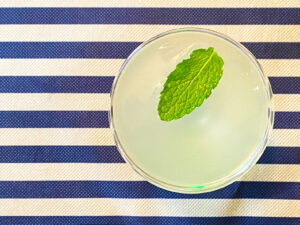The worst thing that ever happened to mint was toothpaste.
It’s just sad. This superb herb, one equally serviceable in culinary applications both sweet and savory, is instead most closely associated with the oral prophylaxis we perform after eating.
Mint was first hailed as a digestive aid by the ancient Egyptians in 1550 BCE; in the centuries that followed, the aromatic sprig was heralded variously for its (mostly imaginary) ability to prevent pregnancy, silence flatulence, and cure more than 40 different ailments—as well as dress up lamb chops and make a great cup of tea.
But in the past half-century, mighty mint has been relegated mostly to the Personal Care aisle. Yes, mint is almost always available in the produce section, just begging to dress up your Greek salad or Asian stir fry. But a large proportion of the mint produced in the United States is used to create mint oil—more than 5 million pounds of oil each year—and most of that, I’m certain, ends up in dentifrices, mouthwashes, and breath lozenges.
Today mint is less a food and more of a detergent.
Fortunately, it’s still one of the all-time great cocktail ingredients.
Mint probably made its first appearance in a bar glass as mere decoration. As Dale DeGroff writes in The Craft of the Cocktail, “Mint for garnishing has been a part of the American beverage since colonial times, when it appeared in the first brandy and peach-brandy juleps that were a signature early-American drink.”
Today, the Mint Julep is by far the most familiar mint-forward drink, thanks mostly to its long association with the Kentucky Derby. Residents of the Bluegrass State might not want to hear it, but the Julep probably originated in Virginia in 1770, although early versions used rum, not bourbon, as its base spirit.
Is it essential to shell out for silver or pewter cups, Kentucky’s signature serving vessel for Mint Juleps? Absolutely not. We own a set, but they’re cheap knockoffs that seem to tarnish before we can finish our drinks. A highball glass works just as well. Besides, the sooner the Mint Julep is disassociated from the antiquatedness of horse racing and plantation culture, the better.
Runner-up for most-requested minty cocktail is doubtless the Mojito, which is a mere youngster compared to the Mint Julep. The Oxford Companion to Spirits & Cocktails traces the rum-based Mojito’s origins to early 20th-century Cuba but adds that the drink didn’t really become popular in the United States until the 1980s, where it trailed only the Cosmopolitan in popularity in bars.
Since then, the Mojito has been subject to all kinds of modification and enhancement. An Old Cuban, for example adds bitters and substitutes champagne for seltzer, while a Gin Gin Mule utilizes gin and ginger beer. And like its cousin the Daiquiri, the Mojito lends itself to the incorporation of all manner of fruit, from strawberry and mango to pineapple and coconut.
For me, the highest and best use of mint in a cocktail glass is in a South Side—a more aromatic take on the classic sweet-and-sour Gimlet. I am, of course, strongly partial to gin as the base liquor, but as always the vodka lovers have their own, entirely legitimate version.
Enjoy the minty freshness. And don’t forget to brush.
Mint Julep
Adapted from The Bar Book: Elements of Cocktail Technique by Jeffrey Morgenthaler
10 mint leaves
1 teaspoon simple syrup
2 ounces bourbon
Mint sprigs for garnish
In the bottom of a Julep cup or highball glass, combine mint leaves with simple syrup and muddle gently. Add bourbon and stir. Slowly stir in crushed ice until cup or glass is packed, then mound ice on top. Garnish with mint sprigs, pushing stems deep into the ice. Serve with metal straw.
Mojito
Adapted from Cocktails with a Twist by Kara Newman
6 mint leaves
2 teaspoons sugar
1 lime, quartered
2 ounces white rum
Seltzer
Mint sprigs and lime wheels for garnish
In a Collins glass, gently muddle mint and sugar. Add lime quarters and muddle to release juices. Add rum, stir, and add ice. Top with seltzer and garnish with mint sprig and lime wheel.
South Side
Adapted from Liquor.com
5 mint leaves
1 ounce fresh lemon juice
2 ounces gin
1 ounce simple syrup
Mint sprig for garnish
Put mint leaves and lemon juice into a shaker and gently muddle. Add the gin and simple syrup with ice, and shake until well-chilled. Double-strain into a chilled cocktail glass. Garnish with a mint sprig.

